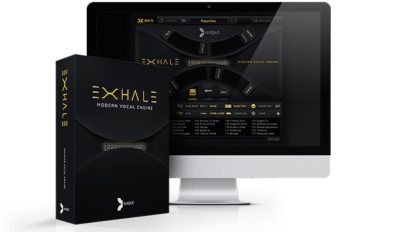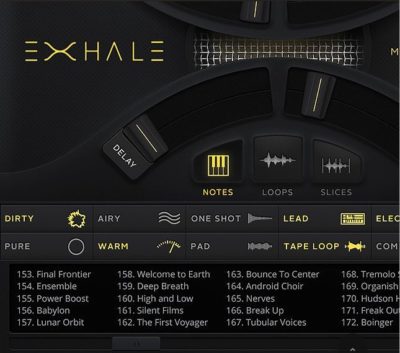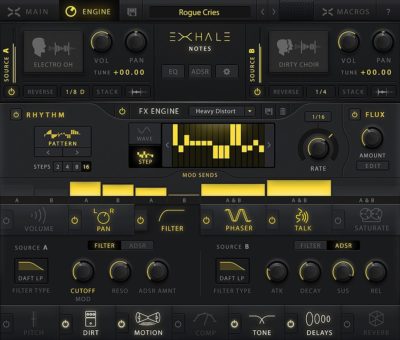New Software Review: Output Exhale
A few months back, I was asking a colleague what plugin had him really hot and bothered. He said Output Exhale, a new vocal instrument for Native Instruments’ Kontakt platform, was it for him. He sent me a link and I checked it out.
Reading through the literature and watching some promotional videos, I had to admit that it seemed cool, but to be honest, I was a bit skeptical. I remember thinking something along the lines of, “Oh this is going to be on everything. It’s going to get overused. Everyone’s tracks are going to have this on it.”
My friend implored me to dig further though, and maintained that this wasn’t like anything else, and unlike auto-tune, wasn’t something that you could overuse, but rather, a compelling and flexible instrument that you could really sink your teeth into and customize. So I took the challenge and gave it a go!
Features and Use
As soon as I had installed and launched Exhale, I was able to navigate around and begin getting some pretty unique sounds. To get started quickly, you’ll want to make sure to have Native Instruments’ Kontakt already installed, as Exhale will run from this, using Kontakt as its wrapper.
Contrary to my anticipations, Exhale is not a vocal sample library, but truly something else. It is a virtual software instrument based around the human voice, so instead of a basic sampled and pitched sample library stretched across your controller, you have a truly unique virtual instrument and vocal engine at your disposal.
The sounds are not mere ohhs, ahhs, and lahhhs like most prior vocal instruments (though these are there if you want them). Exhale is a playable and customizable creative tool, and they have really gone the extra mile to create modern vocal sounds.
The layout for Exhale is very intuitive and well thought out too. It is even comfortable to use with a track pad instead of a standard mapped keyboard controller.
Exhale has 3 different modes that allow for different kinds of creation and customization—“Notes”, “Loops”, and “Slices”.
There are 500 unique presets to use as starting points, which amounts to 10 GB of raw material, and there is even one expansion pack already available. ($35 for Ambient Vocals.)
In the “Notes” mode, Exhale allows to control the material much like you would control a synthesizer. There are vocal sounds here that meld together like a pad, or are glitchy, or stuttery. (We will get to how these can be customized in a moment.)
It was immediately intuitive, the way each of the parameters are laid out, and you are able to search through the sounds in a very sensible way by choosing characteristics like “airy”, “pad”, or “lead”, for example. There is also a user area where you can store your own presets.
“Loops” mode is handy for things like triggering elements for a performance or generating a good groove to base a track off of. As this is a virtual instrument, you can have a number of loops triggered by each controller key.
The search parameters mentioned above are consistent throughout, so you can continue browsing based on a general aesthetic in Loops mode as well.
Lastly, in “Slices” mode, you have a more singular approach to these kinds of sounds. (Though you can still loop these “slices” by holding down the note after you’ve triggered them.)
These sliced and isolated pieces can be powerful when applied in a songwriting or track-building context. Their shorter nature and the ability to do some concise editing from within Exhale makes this a useful tool for adding a backing element that is humanized, and can sound as dramatic or as subtle as you like.
Effects and Extra Features
Output has really done a great job of creating some unique and modern vocal sounds in Exhale. With the custom presets—and the custom macros available for the existing presets—you can really get under the hood with all of the sounds here, making each of them suit your own tastes and needs.
In some cases, even simply dialing back the present processing for the “less is more” approach is just as satisfying as the ability to dig in and add new effects.
When editing the voices here, there are essentially two main pages for you to dig into. The first of these pages is “Main” where you have the sliders that control 4 main parameters of behavior. These provide control over some pretty interesting parameters like “talk”, “delay”, “shape”, and “spread” for example, and are accessible in all three of the modes listed above.
Up at the top of the window, next to “Main”, is where you will find the button to switch to the second page, called “Engine”. This is where you can look under the hood and find typical ADSR controls, as well as a reverse loop function.
Here, you’ll also find a “wave shape pattern” menu, full of highly customizable options including rate controls and flux amount, as well as rhythmic pattern control.
Below this are menus for overall settings including Volume, Pan, Filter, Phaser, Talk, Tape Saturation follwed by a bottom row of controls for Pitch, Dirt, Compression, Tone, Delays, and Reverb. All of these have the ability to be toggled on or off and everything within the Engine can be assigned to a Macros on the main page once you have them set up to your taste.
You can also use this page to save your presets, select a key from a Major or Minor menu, orcreate of snapshots for Maschine, and automate inserts.
Critical Considerations
For all it gets right, there are a few potential issues to consider with Exhale.
First, when working with the features and parameters listed above, bear in mind that there is NO undo function, so you are going to want to create snapshots within Kontakt. (Similar to a “save as”.)
Within your preset, you can save these snapshots, either by overwriting or doing a save as. From here, you can return to prior states fairly easily if needed.
There is also no way, as of this writing, to load in your own samples and sources to Exhale’s vocal processing engine. This is definitely a feature I would personally love to see added,and could help make an already flexible and original tool even more so.
As with anything that has a distinctly “modern” sound, it is also good to keep in mind that music tastes and trends change, and so I hope that Output continue to create new updates and expansions for this amazing tool, allowing it to continue to feel as fresh and current as it does today, for years to come.
Summing it Up
Exhale is a great sounding piece of kit to have in your arsenal. It allows electronic music composers to add an oft-missed human feel to their tracks, gives songwriters an extra element to work into their demos and compositions, and provides film composers and the like an incredible atmospheric instrument, and so much more for many others.
A $199 price point is also hard to beat, especially when Output offers the guarantee of a 14 day risk-free return policy.
Is this a must have for everyone? Maybe, maybe not. It really depends on what you do. Is this a must try out for everyone? Definitely—decidedly so. I am usually one to cringe at the “I told you so”s, but I can bet that my colleague has one waiting for me.
Kallie Marie is a producer, composer and educator who lives in New York.

Please note: When you buy products through links on this page, we may earn an affiliate commission.









